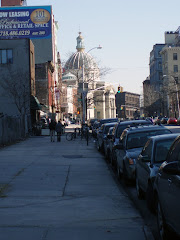Actually, a slight digression from the digression. There is a man named Ralph McInerny who teaches at Notre Dame and who also writes mystery stories. You might not know his name but you probably know the name of his most popular character: Fr. Dowling, if only from the TV series back in the 1980s. And no disrespect meant to Tom Bosley who is a fine actor and one whose performances I’ve always enjoyed, but the Father Dowling Mysteries on television bore little resemblance to the mystery stories they were based on. The stories are very good; and I say that as one who hasn’t been in a church in thirty years but for the funeral of relatives.
But one thing always intrigued me in those stories, which is that his characters, who are almost always Roman Catholic, always identify themselves to each other by the parish they live in rather than a particular neighborhood or part of town. Where I grew up in Connecticut no one would do this. This is either a Midwestern thing or Fr. Dowling’s town is so small it hasn’t any neighborhoods. But Ralph McInerny’s characters take their churches seriously.

Then I began walking around Brooklyn, which was once truly known as the City of Homes and Churches. You never did know a place with so many churches. Synagogues and mosques, too, but the churches predominate by a good measure. It seems like you can’t walk for a few blocks anywhere in Brooklyn without running up against a church. Sometimes they are hidden away among warehouses and small industries like St. Lucy’s Old Roman Catholic Cathedral on Kent Avenue in Williamsburg (above) or have a spire that can be seen for miles like St. Michael’s Church on 4th Avenue in Sunset Park; often they may be in a modest storefront. There is a block of Ralph Avenue in Bed-Stuy that is lined almost from one end to the other with storefront churches, Holiness Churches, Fellowship Churches, Churches in, through, by, and with Christ, and so on.
There are churches that look rooted in the soil for a century or more and churches that look like they were built the day before yesterday. There are churches prominent in Brooklyn history like the Dutch Reformed Church in Flatbush or Henry Ward Beecher’s Plymouth Church in Brooklyn Heights. Then there are the Kingdom Halls in various parts of town and the Brooklyn Tabernacle (of the world famous choir) downtown on Smith Street that is like a Brooklyn version of a mega-church.
And what I found was that I began marking my own walks by the names of churches I passed since they were often the most prominent landmarks. Where did I turn off Ft. Hamilton Parkway in Borough Park? Oh, yes, St. Catherine’s of Alexandra. Where did I turn to start my walk back the first time I was in Bay Ridge? Sure, it was St. Ephraim’s. Some have become like old friends because I pass them so often: St. Luke’s on Clinton Avenue near Atlantic Avenue; Cadman Memorial at Lafayette and Clinton; the Apostolic Faith Mission at Lafayette and Washington. And one of my favorites: Queen of All Saints at Lafayette and Vanderbilt.

I am intrigued by Queen of All Saints (left) because it takes up half the block between Vanderbilt and Clermont Avenues, the other half being occupied by a Masonic temple (below). Both buildings are enormous and compliment each other well though the church is in the French Gothic style and the temple wouldn’t look out of place among the federal buildings in Washington. I'm not familiar with Masonic temples but as what is sometimes called a "lapsed Catholic" I've seen my share of churches and I can't remember such an enormous combination of church and school in the same building. I gather they were both constructed around the same year, 1910-1911, and knowing the tender feelings the church has always borne toward the Masons, I have woven a fantasy with the Grand Master of the Masons and the Bishop of Brooklyn standing out on Lafayette Avenue, each urging his respective architect to add more height lest one be overshadowed by the other until finally, exhausted, they call a truce. No matter, the two together provide one of the more imposing sights in Ft. Greene.

Brooklyn could have one of the most diverse selections of churches, synagogues, mosques, and other houses of worship in the country and it might be interesting to see how many I can note in the coming months.

